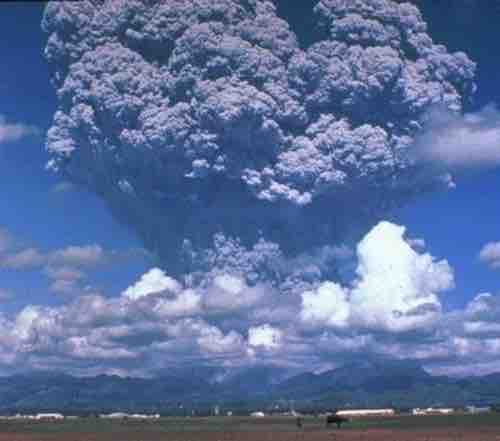Volcanoes form at locations on the Earth's surface where tectonic plates converge or diverge. They release lava, gas, and ash, acting as vents for magma chambers miles below the surface. There are approximately 1,900 active volcanoes on the Earth's surface.
Volcanic Eruptions
A volcanic eruption, such as that of Mount Pinatubo in the Philippines, can cause severe environmental damage.

Volcanic eruption
The 1991 eruption of Mount Pinatubo in the Philippines.
Volcanic eruptions and lava can cause immediate danger to the surrounding area. The extremely hot lava can burn houses and forests very quickly. The ash can also make air travel difficult and be transferred over long distances by the wind, sometimes causing respiratory ailments such as asthma. Volcanoes can also cause more delayed damage through the gases and particulate matter that are released into the atmosphere.
Contribution to Air Pollution
Volcanoes can contribute to air pollution through the release of toxic gases, which can include water vapor, carbon dioxide, sulfur dioxide, hydrogen sulfide, hydrogen chloride, and hydrogen fluoride, along with trace amounts of hydrogen, carbon monoxide, and hydrogen fluoride. Carbon dioxide is a greenhouse gas, and sulfur dioxide, hydrogen chloride, and hydrogen fluoride are all components of acid rain. Sulfur dioxide is converted into aerosolized sulfuric acid, which reflects solar radiation and leads to atmospheric cooling, agricultural decline, and occasionally famine. The release of these gases has also been linked to breathing problems and nausea in communities near volcanoes, such as the Hawaiian islands.
Volcanic Activity
Volcanoes are considered active if they have had an explosion in the last 10,000 years. They have extremely long life spans and can appear to be inactive for many years before erupting with little warning. Often, eruptions are preceded by an earthquake or the release of new gases from the volcano. When either of these warnings happen, scientists monitor the volcano more carefully and may call for an evacuation of the surrounding towns.
Volcanoes can also have beneficial effects on the surrounding environment. Volcanic rocks, for example, add a variety of nutrients to the soil, which can improve agricultural yields.